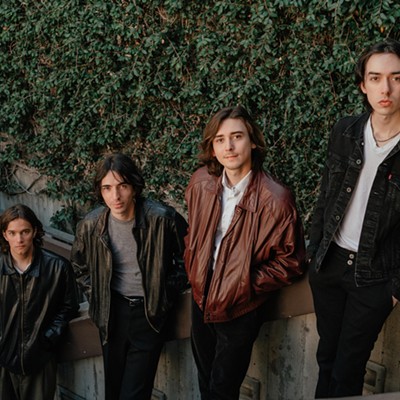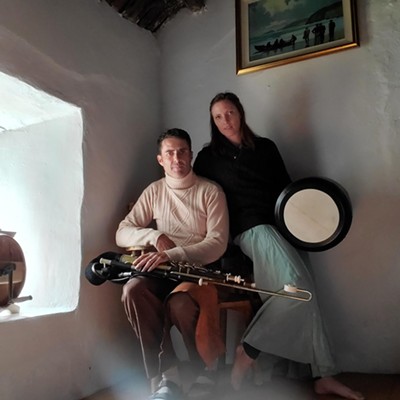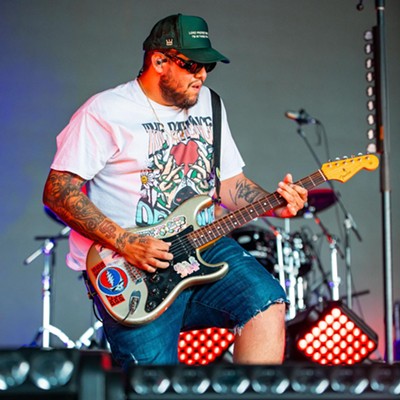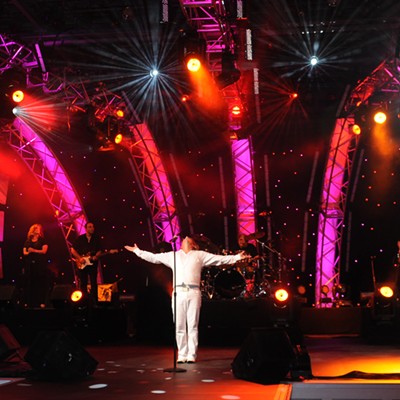I'm anxiously awaiting a phone call from Barry Flanagan. He's the New Jersey kid who, almost 30 years ago, migrated halfway across the world to pursue his dream of studying Hawaiian music and slack-key guitar.
Inspired by Gabby Pahinui, the grand master of this art form, Flanagan and Hapa—the duo which released its first album in 1993—has taken Hawaiian music into realms previously unexplored. Merging jazz, folk, rock and even country with traditional Hawaiian chants, Polynesian rhythms and the slack-key stylings so easily identified with the Hawaiian Islands, Hapa has redefined the possibilities and scope of Hawaiian music.
I'm all set to ask him questions like: Did anyone within your family or musical circles think it odd that you would pursue your dreams through such a relatively marginal musical niche? Just how did you get Stephen Stills to record with you on the groundbreaking first album? And perhaps most importantly, what happened between you and Keli'i Kaneali'i, the other half of the original Hapa, that in 2001 dissolved a partnership with the guy you had once referred to as your "musical soulmate"?
Flanagan, however, due to a minor medical emergency, is unavailable, and so instead, I'm speaking with Nathan Aweau, the gifted 12-string guitarist and bass player whom Flanagan has discovered and recruited to resurrect and re-create a second-generation Hapa.
Ironically, it was Don Ho, an icon of traditional Hawaiian music, who was instrumental in bringing Flanagan and Aweau together. On the surface, Ho appears to be the least likely candidate to facilitate a musical meeting of the minds, given Flanagan's expansive approach to the genre. But Aweau, Ho's arranger for 13 years, disputes this notion.
"The musicianship and musicians (playing with Ho) were incredible, and I learned a lot. At the time, I was writing a lot of jazz and light pop, and it was Don who actually told me to think more about a solo career and to write Hawaiian music. The night Barry came to see us, Don decided to feature me, and Barry realized that's the voice he had been looking for."
If the original collaboration with Kaneali'i seemed odd—East Coast Irish kid teams up with native Hawaiian—this new version of Hapa seems even more improbable.
"We used to laugh about it a lot," said Aweau, "how I struggled with the (native) language, was into jazz and pop and really more into Western music, while Barry was totally opposite."
Aweau said Flanagan made it clear that incorporating the music of first-generation Hapa, specifically the first two albums, would remain integral to the new group, but that it was also essential that Hapa continue to evolve and forge its own identity. Aweau, slowly but surely, began taking on the role of a full-time musical partner.
On stage, Aweau's versatility—alternating between differently tuned 12-string guitars—did much to rebuild the new Hapa sound. But it was his energetic application of the seven-string bass that redefined Hapa as a re-emerging and dynamic performance ensemble. Together, he and Flanagan were achieving much more sound than one would expect from just two individuals.
One reason for all that sound comes from Aweau's developing solo career, in which he was used to recording multiple instruments in search of a more complete sound. Another factor is Flanagan and Aweau's shared love of jazz. Clearly, however, it was recording Maui, which was released in 2005, that was a turning point for the group. It's a recording that rivals the debut CD in terms of its sheer artistry, incorporating up-tempo tunes with ballads, and instrumentals with traditional chants. But with the addition of the bass and a specific intention to not play it safe, Hapa hit the proverbial home run. The duo went out of its way to incorporate other South Pacific cultures and languages into a Polynesian gumbo that would also include contemporary jazz and blues. Topping it off were the traditional Hawaiian chants of frequent guest collaborator Charles Ka'upu.
"We gave everything we had on that album," remembers Aweau fondly, "including the kitchen sink!"
Flanagan (with whom I spoke later) also credits a local Hawaiian kava bar and its cast of colorful characters for much of Maui's inspiration. "I had a very exact plan to go in another direction (from previous albums) and do something completely different. I'm happy to say I think that worked out to be 99 9/10 percent true."
In many ways, Maui was also a coming-out party for the new Hapa. Not only was Aweau more fully introduced to the Hapa faithful; it was also a statement CD—that Hapa was back, as a continuing musical exploration that would push the boundaries of what the outside world might perceive as Hawaiian music.
I asked Flanagan if he ever gets frustrated by the glass ceiling so often applied to Hawaiian music—that you can only go so far or do so much with it. He said, "I believe that everyone on Earth is put here to discover their sense of purpose. My purpose is to change the way the world thinks about Hawaiian music, and that it's not just steel guitars. The glass ceiling is really quite fantastic, as I can see so clearly right through it. We are modernists bringing this music to a brand-new audience."
Flanagan, like Aweau, occasionally performs solo. In addition to these gigs, Aweau continues to work in his home studio, while Flanagan's long-term project is some kind of Hawaiian Riverdance. "You know, a Polynesian rock opera, but with 300-pound dancers!"







